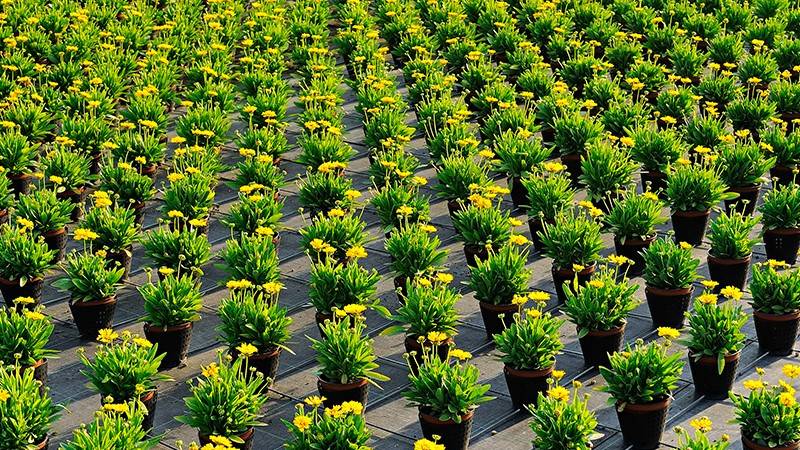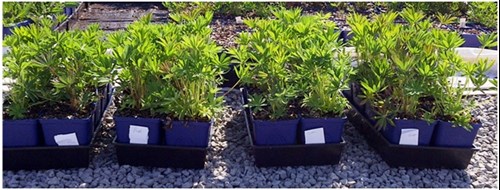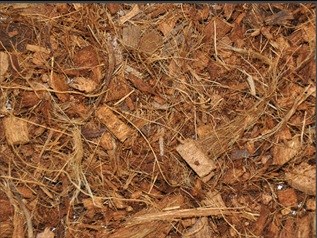Nursery Crops and Bark Media

With all the new trends in horticulture, container-grown ornamentals remain an important crop in the industry. The number of plant species grown in containers has increased, from trees to shrubs, ornamental grasses and perennial plants. All these crops have long production cycles and some can last more than two years.
This longer production time, in comparison to greenhouse annuals, requires different growing practices and needs throughout the production cycle. There are several factors to consider when growing long-term containerized crops:
Containers
Nursery containers are diversified and have been designed for the needs of all types of crops, including perennials, fruit trees and small shrubs and trees. Trees and shrubs grown in containers are easier to manage versus growing them in the field. Container manufacturers provide features in their product offerings such as coating the inside of the containers with copper or putting air holes in the sides of the pots, both of which promote root pruning which limits root coiling. Quality container-grown crops must have limited root coiling so the plant does not become pot-bound and incapable of rooting out in the soil after transplanting.
Irrigation
Daily irrigation is a major concern and water supply is sometimes very limited, especially in states that experience exceptional drought. More and more, state legislation requires water usage monitoring and taxes on the amount used in many areas.
Not only is water becoming scarce, but it can be costly to treat or to purchase if the water source from a well runs out. Recycling water is becoming a common practice and requires monitoring to ensure that salts, nutrients and alkalinity are ideal for the crops grown, and good sanitation is needed to kill pathogens that can be found in recycled water.
Fertilization
Most container-grown crops are fertilized using controlled-release fertilizers. This is more convenient for the grower and the end user as the plant’s nutritional needs are taken care of. Controlled-release fertilizers can be incorporated into growing media, which saves the grower time from having to top dress each container. The quantity of controlled-release fertilizer added per cubic yard of the growing medium must accommodate the crop's needs. The bark used in growing media can immobilize some nitrogen.
This is especially true if the bark is fresh and has not gone through a “composting process”, or if the growing medium contains a high percentage of bark. Controlled-release fertilizers should be applied when the crop is actively growing, not when plants are beginning to harden. If not, the fertilizer salts can become high, reducing crop survival rates when they are exposed to freezing temperatures or other stresses that occur during production.
Weed Control
Weed control in container crops is a big challenge and the use of herbicides is not always possible or can harm crops. Pre-emergent herbicides are available but must be applied before weed seed germinates. Post-emergent herbicides can cause phytotoxicity and must not be used when plants are actively growing. Because herbicides can cause crop damage, a lot of hand weeding is required. Growers are using weed barriers like rice hulls and bark as top dress to reduce the emergence of weeds and liverworts.
Growing Media
Growing media for containerized crop production must have good drainage capabilities and limited shrinkage and compaction over time. Many growers use growing media with various combinations of bark, peat moss and sand. Pine bark used in container media is undoubtedly a great component. It provides the long-term drainage and aeration needed by plant roots. It also increases the bulk density of the growing medium and therefore stabilizes the container in windy conditions.
However, if the bark is not composted or aged sufficiently, it can immobilize the nitrogen needed by plants, causing nitrogen deficiency. Now, other sources of aggregates, like coir and rice hulls, are beginning to be incorporated to help reduce nitrogen immobilization and improve crop quality.
Storage of Growing Media
Growing media with a controlled-release fertilizer must be used within one month after manufacturing, especially during hot summer temperatures. Salt levels coming from the controlled-release fertilizer can increase over time in storage and cause crop burning or toxicity. Bulk growing media should also be used quickly as naturally occurring microbes can start “composting” the pile, creating heat and causing the breakdown of the media's components. PRO-MIX® BKI is a great growing medium to use for container production, but it does not contain any controlled-release fertilizer, so the product can be stored for up to 6 months.
Chunk Coir - New Component for Container Production
Unlike most organic growing media components, coir easily absorbs water. Chunk coir can be a valuable additive in bark-based growing media because it helps manage water use. Trials that compared plant growth between growing media amended with chunk coir vs. bark-based growing media showed, in general, that chunk coir produced as good a crop as the bark growing media. One of the initial advantages of chunk coir was that it helped the initial wetting of the growing media.
Liners rooted out very well and the growing media held water and nutrients. The results from one long-term trial showed lupines that were planted in spring were ready to sell the following spring just like those grown in the bark growing media.

This picture shows the results of a one-year trial with lupines. The growing media from left to right are:
- Peat, chunk coir and 10% bark
- Peat, chunk coir and 25% bark;
- Peat and 35% bark; and finally,
- Peat and 20% chunk coir.
All growing media produced similar crops, but the lupines planted in growing media with chunk coir were slightly better.

Growing media amended with chunk coir retain more water than bark growing media. Therefore, there is a significant reduction in water usage and fertilizer run-off, both of which save money. These benefits are especially important for areas with restricted watering. For employees, the lighter bulk density of the chunk coir growing media in comparison with the traditional bark mixes makes them easier to handle and reduces handling fatigue.